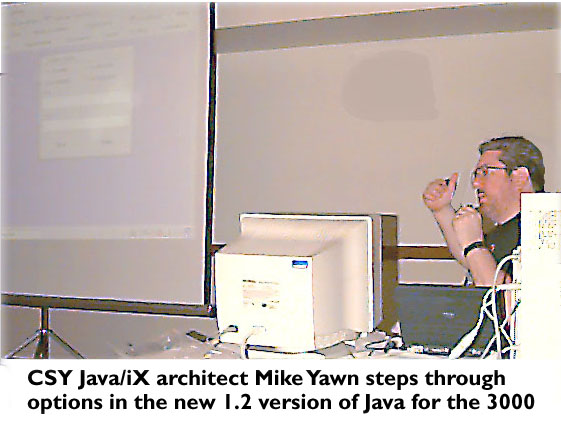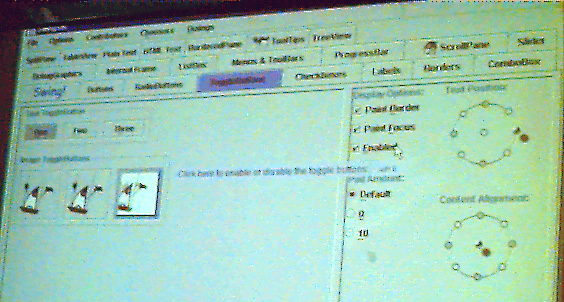
Click here for Adager sponsor message
CSY supports Java for 3000
application development
HP’s new Small VM doesn’t impact CSY
support of Sun standard
HP 3000 division (CSY) Java manager Mike Yawn
wanted to get one
thing clear before he announced full support for Java/iX
starting
with MPE/iX 6.0. HP’s latest plans for a new Java
element aren’t
causing any rift in CSY’s partnership with Sun or its
support
of Sun’s Java standards.
 “It
really doesn’t affect those of us in HP’s server and computer
businesses,” Yawn said. “On the HP 3000 and the
HP 9000 we will
continue to get our Virtual Machine (VM) technology license
from
Sun. There’s quite a bit more to it than what’s
called the “Small
VM” that’s been replicated. There’s more to
Java than the Virtual
Machine.”
“It
really doesn’t affect those of us in HP’s server and computer
businesses,” Yawn said. “On the HP 3000 and the
HP 9000 we will
continue to get our Virtual Machine (VM) technology license
from
Sun. There’s quite a bit more to it than what’s
called the “Small
VM” that’s been replicated. There’s more to
Java than the Virtual
Machine.”
The buzz was raised in the SIG-Java meeting at this
year’s IPROF
conference, sponsored by Interex in Sunnyvale in mid-March. The
day before the SIG meeting the Wall Street Journal had asserted
that HP was marketing a Java “variant, and breaking
with Sun Microsystems
Inc. and opening a rift in an industry alliance.”
Yawn explained that Java is more than a virtual machine,
the part
of the environment which runs applications on a specific
platform.
In HP’s new plans, platforms such as laser printers
will get their
own version of the Java Virtual Machine, one that HP built
itself
to eliminate licensing similar code that Sun had developed.
Instead
of a technical watershed, the move appears to be a business
ploy.
“At this point, HP’s replication of the
Virtual Machine isn’t
interesting to those of us on the server side, and
we’re not suddenly
going to change horses in mid-stream,” Yawn said.
SIG-Java co-chair Gavin Scott reported later that the
new HP “Small
VM” won’t have an impact on the standard, now
being supervised
by Sun under the auspices of the ISO.
“This is nowhere near as big a deal as you might
think from the
news stories of the last several days,” Scott said.
“The initial
reports implied that HP was breaking away from the Sun standard
just like Microsoft, which was going to fragment and eventually
destroy Java. Of course, the reality is that nothing could be
further from the truth.”
HP said its VM announcement is designed to push control of Java further into a standards body and away from Sun’s influence. Scott said the Small VM won’t be changing the standard.
“What HP has announced is simply a Virtual Machine
implementation,
which is independent of the Java language, so there
isn’t much
opportunity for them to fragment the Java world,”
Scott said in
a posting to the Internet. “HP is fully committed to
Java compatibility,
and has an extremely strong relationship with Sun’s
JavaSoft division.”
New tools, new version
Yawn, the other SIG co-chair, was introducing the new
functionality
of forthcoming versions of Java to an audience of developers at
IPROF. The 1.1.5 version of the language will be bundled into
the 6.0 release of MPE/iX, expected for release in late summer.
But what was even more interesting was Yawn’s
demonstration of
Swing, the Java Foundation Classes that act as a powerful
interface
tool for Java applications.
Swing is the biggest change between Java 1.1 and 1.2,
and Yawn’s
team is porting 1.2 to the HP 3000 beginning this spring. Yawn
and ORBiT VP of Technology Mark Klein, another MPE/iX Posix
porting
expert, got Java’s 1.2 version to successfully launch
for the
first time on a 3000 over the IPROF weekend. Yawn said that the
Swing classes can also be “backported” into the
1.1 versions of
Java, which might make them available for an HP 3000
implementation
before 1.2 arrives for MPE/iX in 1999. “You don’t
have to wait
until 1.2 to get it,” Yawn explained.
In addition to getting Swing capabilities for interface
design,
“Java 1.1 has almost all the core features you need
for writing
applications,” Scott added. “We’re reaching
a point of some stability.”
By supplying a Java Development Kit (JDK) and a Java
Virtual Machine
in MPE/iX, CSY is committing to bundling the first language
with
the HP 3000 since the 1970s when SPL was included with MPE.
Yawn said the Virtual Machine that’s been available
as freeware
for the 3000 is now being referred to as the “Classic
VM,” and
the next version being prepared for the system is focused
on speed.
“Our priorities for the next year are performance,
performance
and performance,” Yawn said. HP is adding transparent
run-time
technology to Sun’s technology to boost application
performance.
HP will be improving on the HotSpot VM with an Adaptive Runtime
Compiler, and is prepared to create a native Java version
of the
VM for the 3000 if needed to further address performance.
“We want Java to perform just like other natively
compiled languages,”
Yawn said. An NM PROG executable “just like the COBOL
or C compiler
on the platform” is part of HP’s internal R&D
work, now in the
investigation stage.
Control over interfaces
Yawn said that Swing resolves the problems with
Java’s claim of
“write once, run anywhere.” The prior windowing
tool, AWT, “was
a poor implementation of a lousy design,” Yawn said.
Sun changed
the event model of how things interact with each other in Java
1.1’s interfaces, “and in 1.2 they’ve
finally come along with
a good implementation of a good design.”
 Swing
provides ready-made interface elements like buttons for
applications, including some that do on-screen animation to
signal
they’ve been pressed. Labels for items like buttons
can be easily
placed with a toolset that recalls the interface design power
of Visual Basic.
Swing
provides ready-made interface elements like buttons for
applications, including some that do on-screen animation to
signal
they’ve been pressed. Labels for items like buttons
can be easily
placed with a toolset that recalls the interface design power
of Visual Basic.
“Any object – a radio button, checkbox, folder tab – can contain pictures or any other sort of object,” Yawn explained. Swing also makes possible a concept called pluggable look and feel, answering the criticism that Java application interfaces varied from Windows 95 to Windows NT. Developers can control how the interfaces look using Swing, to adopt a Windows or Macintosh look and feel, or the standard Java look and feel. Windows choices are only available while developing from Windows-based platforms to avoid any lawsuits from Microsoft, Yawn added.
Swing can set a default look and feel, called Metal, or
can follow
the look and feel based on the platform the application
runs on.
Sun has added a set of APIs to permit control of the look and
feel from a user level. Swing can be downloaded from the
Sun Javasoft
Web site and installed into Netscape to be used with HP
3000 applications
today, according to Gavin Scott. The Swing components are
written
entirely in Java for minimal performance impact.
The 1.2 design also includes a new collections API, ready-to-use hash tables, b-trees, linked lists, and “just about any sort of data organization you can think of,” Yawn said, “so there’s a class there to do that, so you don’t have to re-implement all that code.”
Java IDL will also add CORBA capability to Java,
providing standards-based
interoperability and connectivity. Web-enabled, distributed
applications
using Java IDL can invoke remote network services transparently
using protocols such as IIOP. Runtime components include a
fully
OMG-compliant Java Object Request Broker – which would
be the
first such ORB component supported for the HP 3000. Yawn
speculated
that the ORB would run on the 3000 serving requests coming in
other ORB platforms.
Database access
HP is providing a native TurboIMAGE class library for
its Java/iX
release in 6.0, a way to call TurboIMAGE intrinsics from Java
applications. The 2.1 version, which can be downloaded from the
CSY Jazz Web server today, provides support for item-level
locking,
Remote Method Invocation (RMI) and JavaBeans, as well as an
expanded
examples directory and a bug fix for handling String type
arguments
to DBGET. These HP supplied classes still need support for
item-level
locking, synchronization for multithreaded applications and
more
consistent exceptions handling.
There’s also a third-party solution in
Adager’s ADBC technology,
implemented by Advanced Network Systems, that uses native calls
to IMAGE/SQL. These third-party classes are being transformed
into a JavaBeans implementation for release this spring.
Scott covered the JDBC options for prospective use with the HP 3000. HP said it is considering nearly a dozen different sources for JDBC middleware on the 3000, and it hasn’t ruled out its own development effort at CSY. A JDBC-to-ODBC bridge can also deliver a way to piggyback on existing ODBC solutions for the 3000, although the meeting didn’t include information on compatible, IMAGE-aware ODBC solutions that have been tested with such a bridge.
Java can be used on HP 3000s natively for application
development,
Scott added, typing a Java program name at a colon prompt
to launch
an application without any Internet links, network or Web
links.
But the language can also serve 3000 needs by being downloaded
as an applet into a Web page, “executed there, and use
it to talk
to a driver to talk to the network to the 3000 or some
other server,”
he said.
“Not only is this going to be the first bundled
language for the
3000, it’s also got the fanciest development
environment available
for it,” Scott added. “You can get Visual Cafe,
Visual Age from
IBM to develop code that can be deployed on the 3000 or put on
the 3000 and downloaded to a Web page.”